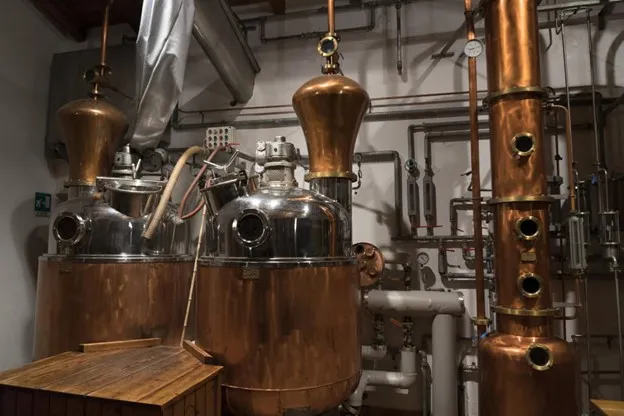For the uninitiated, distillation might seem like a complex, scientific procedure. Yet, it’s more akin to an art form. It’s the marriage of raw materials, technique, and time, creating something that’s more than the sum of its parts. But let’s break it down. At its heart, distillation is the process of heating a liquid to create vapor and then cooling that vapor to create a liquid. In whiskey making, this process is used to separate alcohol from the fermented grain mash.
The initial fermented grain mash—often a mixture of corn, rye, wheat, and malted barley—is heated in a large pot or column still. As the mash heats, alcohol and other compounds evaporate because they boil at a lower temperature than water. This alcoholic vapor is collected and cooled in a condenser, creating the raw spirit. From here, the spirit will usually undergo a second distillation to further refine the product. This stage can make or break a whiskey’s flavor, as it’s where the distiller decides which elements to keep (the heart) and which to discard (the heads and tails).
The distillation process is a delicate balance between science and art, where the distiller’s expertise plays a crucial role. Each step, from the selection of grains to the temperature control during heating, influences the final product. One key point to highlight is the importance of the distiller’s decision during the second distillation. This is when they carefully separate the hearts, heads, and tails of the distillate, ensuring that only the purest and most flavorful elements make it into the final whiskey. Additionally, the choice of still—whether it’s a pot still or column still—can also impact the flavor profile. Pot stills tend to produce a more complex and robust spirit, while column stills offer greater efficiency and a lighter character.
How Distillation Impacts Whiskey Flavor
Now, onto the fascinating aspect of how distillation influences flavor. It might surprise you, but distillation isn’t just about alcohol production. The process also shapes the character and complexity of the whiskey. During distillation, the interaction between the grain, yeast, and still can create a range of flavors. This is further influenced by the distiller’s skill in separating the ‘cuts’—the flavorful heart from the less desirable heads and tails.
But the magic doesn’t end there. Once distilled, the clear spirit is aged in wooden barrels. It’s during this maturation period that the whiskey takes on additional flavors from the wood, evolving into the amber liquid we love. The interplay between the distillation process and aging gives each whiskey its distinct profile, which you can discover in the diverse range available at WhiskeyD.
Distillation is not just about alcohol production; it is an intricate process that shapes the unique flavors found in whiskey. The distillation technique, including the selection of yeast and the still design, plays a significant role in defining the spirit’s character. For example, the shape and size of the stills can influence the level of copper contact, which can remove unwanted compounds and contribute to a smoother taste. Furthermore, the interaction between the spirit and the copper during distillation can enhance desirable flavors and aromas. It’s important to note that while distillation sets the foundation, the aging process in barrels is equally crucial. The wood imparts its own flavors and allows the whiskey to mellow and develop complexity over time.
The Tapestry of Distillation Practices Across Different Regions
The world of whiskey is richly diverse, thanks to different distillation practices across various regions. Let’s start with Scotland. Here, malt whiskey distillation usually involves two copper pot stills in a batch process. The first, the wash still, removes the alcohol from the fermented mash (the wash). The second, the spirit still, refines the product further. The final spirit is a result of the distiller’s expertise in taking the heart cut.
Moving to Ireland, the practice of triple distillation is common. The extra round of distillation creates a smoother, lighter spirit, often associated with Irish whiskey.
Meanwhile, American bourbon, produced mostly in Kentucky, undergoes a different process. The fermented mash is distilled at no more than 160 proof and entered into the barrel at no more than 125 proof. This results in a full-bodied and flavorful spirit, which is then mellowed by aging in new, charred oak barrels.
However, the distillation process is not set in stone and continues to evolve, with distilleries worldwide innovating and experimenting. For instance, some are adopting unusual grains, while others are experimenting with different yeast strains or distillation techniques. As such, distillation remains a dynamic and exciting aspect of whiskey production. Whether you’re new to the world of whiskey or a seasoned connoisseur, there’s always something new to learn—and taste—such as the expertly curated selection at WhiskeyD.
Different regions have distinct distillation practices that contribute to the diversity of whiskey styles. Scotch distilleries, for instance, predominantly use copper pot stills and follow a batch distillation process. This traditional approach results in a spirit known for its rich and complex flavor profile. On the other hand, Ireland is known for its triple distillation method, which creates a smoother and lighter spirit. The extra round of distillation removes impurities and contributes to the distinct character of Irish whiskey. In the United States, bourbon production involves specific regulations, including the use of new, charred oak barrels and restrictions on distillation proof. These practices result in the signature bold and full-bodied nature of bourbon. The variations in distillation practices across regions not only shape the flavors of the whiskey but also reflect the cultural and historical traditions unique to each location.
So there you have it—the art of whiskey distillation in a nutshell. From the basic steps to the influence on flavor, and the fascinating variations across regions, it’s clear that distillation is indeed an art, as intricate and rewarding as any. Next time you enjoy a glass of whiskey, take a moment to appreciate the craftsmanship that went into every drop. After all, distillation is more than a process—it’s the heartbeat of whiskey.

